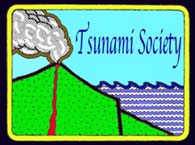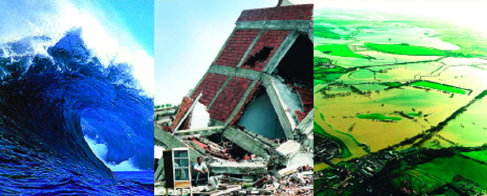ISSUES - Year 2011
ISSN 8755-6839
VOLUME
30, No. 4 (2011) 
ABSTRACTS
for Volume 30, No 4
Complete Journal - STHVol30N4Y2011 (PDF Document 10.9 MB)
..........................................................
OBSERVATION OF TSUNAMI RADIATION AT TOHOKU BY REMOTE SENSING
Frank C. Lin - Dept. of Mathematics and Computer Science, University of Maryland Eastern Shore Princess Anne, MD., USA.
Weiwei Zhu - Dept. of Mathematics and Computer Science, University of Maryland Eastern Shore, Princess Anne, MD., USA.
Kingkarn Sookhanaphibarn - Intelligent Computer Entertainment Laboratory, Dept. of Human and Computer Intelligence, Ritsumeikan University Kusatsu, Shiga, JAPAN
ABSTRACT
We present prima facie evidence that upon the onset of the Tohoku tsunami of Mar. 11, 2011 infrared radiation was emitted by the tsunami and was detected by the Japanese satellite MTSAT-IR1, in agreement with our earlier findings for the Great Sumatra Tsunami of 2004. Implications for a worldwide Tsunami Early Warning System are discussed.
Keywords: Tsunami, Tsunami Radiation, Tsunami Signal, Tsunami Early Warning System, Tohoku
Science of Tsunami Hazards, Vol. 30, No. 4, (2011) (pages 223-232)
------------------------
TOWARD INDONESIAN TSUNAMI EARLY WARNING SYSTEM BY USING RAPID RUPTURE DURATIONS CALCULATION 233
Madlazim - Physics Dept., Faculty of Mathematics and Sciences, Surabaya State University (UNESA) Jl. Ketintang, Surabaya, INDONESIA
ABSTRACT
Indonesia has an Indonesian Tsunami Early Warning System (Ina-TEWS) since 2008. The Ina-TEWS has used automatic processing on hypocenter; Mwp, Mw (mB) and Mj. If earthquake occurred in Ocean, depth < 70 km and magnitude > 7, then Ina-TEWS announce early warning that the earthquake can generate tsunami. However, the announcement of the Ina-TEWS is still not accuracy. Purpose of this study is to estimate earthquake rupture duration of large Indonesia earthquakes that occurred in Indian Ocean, Java, Timor Sea, Banda Sea, Arafura Sea and Pacific Ocean using a direct procedure and software developed Lomax and Michelini for rapid assessment of earthquake tsunami potential by deriving two simple measures from vertical component broadband P-wave velocity record. The first is the high-frequency apparent rupture duration, Tdur which may be related to can be related to the critical parameters rupture length (L), depth (z), and shear modulus (?). The second is a confirmation of the earlier finding by Lomax and Michelini, namely that the rupture duration has a stronger influence to generate tsunami than Mw and Depth. We analyzed at least 510 vertical seismogram recorded by GEOFON-IA and IRIS-DMC networks. Our analysis shows that the seismic potency, LWD, which is more obviously related to capability to generate a tsunami than former. The larger Tdur the larger is the seismic potency LWD because Tdur is proportional to L/vr (with vr – rupture velocity). We also suggest that tsunami potential is not directly related to the faulting type of source and for events that have rupture duration greater than 50 s, the earthquakes generated tsunami. With available real-time seismogram data, rapid calculation, rupture duration discriminant can be completed within 3 to 8 min after the P-onset.
Keywords: Rupture duration; Tsunami early warning; Body wave; Earthquake dynamics.
Science of Tsunami Hazards, Vol. 30, No. 4, (2011)
(pages 233-243)
------------------------
TSUNAMI WAVE LOADING ON A BRIDGE DECK WITH PERFORATIONS
P. Lukkunaprasit - Professor, Dept. of Civil Engineering, Chulalongkorn University, Bangkok, THAILAND
T.L. Lau - Graduate Student, Dept. of Civil Engineering, Chulalongkorn University, Bangkok, THAILAND
A. Ruangrassamee - Assistant Professor, Dept. of Civil Engineering, Chulalongkorn University, Bangkok, THAILAND
T. Ohmachi -
Professor, Dept. of Built Environment, Tokyo Institute of Technology, Yokohama, JAPAN
ABSTRACT
Tsunamis have damaged bridges to various extents in the 2004 Indian Ocean Tsunami. This paper reports an experimental investigation of the effect of perforations in the girders and parapets on the horizontal tsunami loads. The results reveal that the maximum pressures impinging on the front face of the pier and deck are 4.5 and 3 times the hydrostatic pressure at 80mm nominal wave heights. The percentage of force reduction of the bridge deck with 10% perforated girders and 60% perforated parapets is found to be close to the percentage of perforation area in the deck. However, it is also noted that perforations in the bridge deck can substantially reduce the tsunami forces acting on it throughout the force time history. Thus, less damage to the bridge is anticipated for the bridge deck with perforations in girders and parapets.
Keywords: Tsunami, bridge deck, experiment, perforation, loading, pressure
Science of Tsunami Hazards, Vol. 30, No. 4, (2011)
(pages 244-252)
------------------------
THE EARTHQUAKE AND TSUNAMI OF JULY 21, 365 AD IN THE EASTERN MEDITERRANEAN SEA - Review of Impact on the Ancient World - Assessment of Recurrence and Future Impact.
George Pararas-Carayannis - Tsunami Society International, Honolulu, Hawaii, USA
ABSTRACT
There is ample evidence indicating that on July 21, 365 AD a great earthquake near the west coast of the Island of Crete generated a mega-tsunami, which was responsible for extensive destruction throughout the Eastern Mediterranean, but particularly on Peloponnesus, the Greek Islands, Sicily, Libya, Cyprus, Palestine and Egypt. It is believed that the combined catastrophic impacts of the earthquake and tsunami were significant catalysts in furthering the declination of the Roman Empire and contributing to its subsequent final division between the East Roman and the West (Byzantine) empires in 395 A.D. In view of subsequent earthquakes and tsunamis in the region and the high probability that a similar great disaster will occur again, the present study reviews and summarizes the seismo-tectonic and kinematic characteristics of the Aegean and Anatolian micro-plates, their interaction with the African and Eurasian tectonic plates and examines and evaluates the historical records pertaining to this 4th Century AD disaster as to the destructive impact it had on the ancient world. Additionally, the study reconciles the impact described in historical and recent records with results obtained by numerical modeling studies, provides a rough estimate of the recurrence frequency of great tsunamigenic earthquakes in the Eastern Mediterranean region and assesses what the future impact may be in view of great increases in population densities along coastal areas.
Key words: tectonics; Eastern Mediterranean Sea; 365 AD earthquake; tsunami
Science of Tsunami Hazards, Vol. 30, No. 4, (2011)
(pages 253-292)
--------------------------------------------
Copyright © 2011 - TSUNAMI SOCIETY INTERNATIONAL
TSUNAMI SOCIETY INTERNATIONAL, 1741 Ala Moana Blvd. #70, Honolulu, HI 96815, USA.
WWW.TSUNAMISOCIETY.ORG




